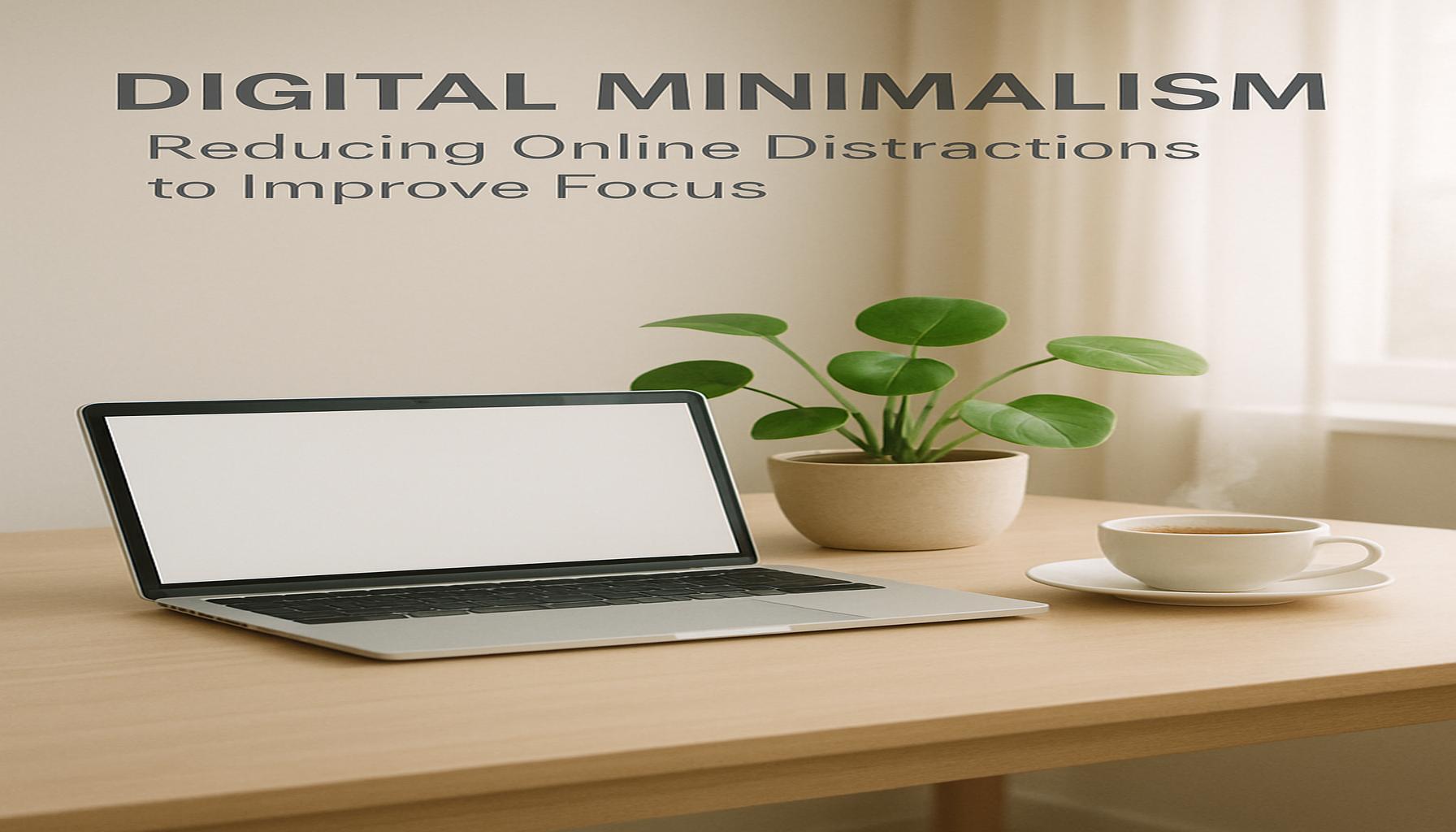The Power of White Space: How Minimalism Stimulates Concentration and Creativity

The Importance of White Space
In our fast-paced society, where multitasking and information overload have become the norm, the idea of white space takes on a significant role. White space can be defined as the unmarked areas within a design or layout, serving as a visual breathing room. While often overlooked, these spaces are critical for enhancing our cognitive functions and overall productivity.
Minimalism—rooted in the principle of simplicity—extends beyond just physical spaces, illustrating how removing clutter can lead to improved mental clarity. Research shows that by adopting a minimalist approach, individuals can unlock their potential for creativity and concentration. For example, consider the work of renowned tech companies like Apple. Their iconic product designs utilize white space effectively, emphasizing the functionality and beauty of their devices without overwhelming users with unnecessary visual elements.
- White space creates room for thoughts to breathe. Just as a spacious room can foster a sense of calm, so can a design that flows effortlessly. It allows users to process information more effectively and stimulates fresh ideas.
- A minimalist design can improve focus and efficiency. In educational settings, for instance, classrooms designed with minimal distractions are often more conducive to learning, as students can concentrate on their studies without superfluous elements vying for their attention.
- Reduced visual distractions foster an environment conducive to innovation. From corporate offices to home workspaces, areas devoid of chaos can inspire employees and creative thinkers alike to innovate without the hindrance of clutter.
These principles of design do not serve aesthetics alone; they have profound psychological implications. Studies indicate that individuals who immerse themselves in simplified environments exhibit increased productivity, showing a notable uptick in their capability to concentrate on tasks at hand. Moreover, such environments enhance problem-solving skills, as reduced stimulus allows the brain to engage in deeper thinking processes. Many people have reported feeling a sense of greater emotional clarity when working in minimalist settings, where distractions are at a minimum.
As our homes and workplaces become more cluttered, embracing the concept of white space offers a solution to regain control over our mental environments. Consider the power of white space in various forms, from distinct art pieces where negative space enhances focal points, to efficient digital interfaces that prioritize essential content. The impact of these mindful choices profoundly influences our cognitive processes, shaping how we interact with the world.
This article will delve further into the transformative power of white space. We will provide practical tips on incorporating minimalism into various aspects of life—from workspace organization to webpage design—thereby illustrating how individuals can harness this powerful tool to enhance their focus and ignite their creativity.

DISCOVER MORE: Click here to learn about embracing minimalism for a peaceful life
Understanding the Psychological Impact of White Space
The essence of white space transcends mere aesthetics; it plays a crucial role in shaping our psychological experiences and capabilities. In environments brimming with distractions, our brains are compelled to work harder to process information, ultimately leading to cognitive fatigue. Conversely, by integrating white space into our surroundings, we can create an atmosphere that promotes efficient thinking and creativity.
One significant benefit of white space is its ability to enhance focus. Research has shown that individuals exposed to cluttered environments tend to experience decreases in productivity and overall satisfaction. On a practical level, consider the difference between a bustling, chaotic workspace filled with papers and gadgets and a clean, minimalist office with organized essentials. The latter encourages a streamlined approach to tasks, enabling individuals to direct their attention where it matters most.
The Role of Minimalism in Education
In educational settings, the influence of white space is particularly pronounced. Classrooms designed with minimal distractions foster a learning atmosphere conducive to deep concentration. For instance, studies reveal that students perform better on tasks in environments where visual clutter is minimized. When students are surrounded by less stimuli, they are more likely to engage meaningfully with the content being presented, leading to higher retention of information and improved academic performance.
Employing white space also provides room for creativity to flourish. Here are a few ways that minimalistic design can inspire creative thought:
- Encouraging Original Thought: With fewer distractions vying for attention, the mind is free to wander and explore new ideas, fostering original and innovative thinking.
- Facilitating Reflection: Minimalist environments grant individuals the necessary time and space to think deeply, enabling critical reflection essential for creative problem-solving.
- Enhancing Visual Appeal: In design, less is often more. Projects utilizing white space allow elements to stand out, enabling viewers to engage with them on a deeper level.
Moreover, the incorporation of white space is not limited to physical environments; it extends to digital landscapes as well. Websites that employ minimalist design principles with adequate spacing between text and images are proven to result in lower bounce rates and higher user engagement. Users are more likely to navigate sites that appear uncluttered and easy to read, illustrating the advantages of white space in improving online experiences.
As creative professionals increasingly recognize the impact of a simplified aesthetic, many are adopting a minimalist mindset. Embracing white space in design not only promotes visual clarity but also serves as a catalyst for concentrated thought and new ideas. The power of white space lies in its ability to enable us to see beyond the chaos that surrounds us, guiding us toward a greater potential for both concentration and creativity.
| Advantages | Description |
|---|---|
| Enhanced Focus | White space reduces distractions, allowing individuals to concentrate on tasks more effectively. |
| Increased Creativity | Minimalist environments encourage innovative thinking by fostering a serene atmosphere. |
| Clarity of Communication | A clean design enhances message delivery, making ideas clearer and more impactful. |
| Stress Reduction | Less clutter creates a calming environment, decreasing anxiety levels and boosting productivity. |
In the quest for increased productivity and creativity, understanding the role of white space becomes vital. This design principle not only makes layouts visually appealing but also enhances functionality. The incorporation of white space encourages moments of calm, allowing the mind to process information without the overload associated with cluttered visuals. Moreover, as workplaces embrace minimalism, employees report a significant uptick in creativity. Environments that prioritize simplicity often empower individuals to explore new ideas, fostering innovation. Effectively, white space serves as a canvass upon which creativity flourishes, offering a contrast to the noise of everyday distractions.Additionally, white space contributes to achieving an effective communication strategy. By prioritizing clarity and reducing visual noise, essential messages stand out, resulting in more effective interactions. When environments are less cluttered, thoughts can flow more freely, translating to better collaboration and team dynamics. Lastly, the psychological benefits of a minimalist approach cannot be overstated. The reduction in visual clutter translates to lower stress levels, enhancing overall well-being and allowing for an increase in sustained focus. This dual benefit of minimalism not only creates environments where creativity thrives but also fosters healthier, more productive habits.
DISCOVER MORE: Click here for insights on simplifying your life
The Practical Applications of White Space in Workspaces
The concept of white space extends well beyond educational institutions and home environments; it profoundly shapes the modern workplace, where functionality and aesthetics are increasingly intertwined. A minimalist workspace can significantly impact an employee’s performance, mental health, and overall job satisfaction. Research suggests that organizations that prioritize clean, decluttered workspaces can reduce stress levels among employees, translating to improved productivity.
Consider the rise of open-plan offices, where large spaces are designed to promote collaboration while minimizing visual distractions. In such environments, the application of white space takes on an essential role. By utilizing sparse design elements such as open seating arrangements and reducing unnecessary decor, businesses can create an atmosphere that encourages interaction without overwhelming employees. These strategic applications highlight the importance of intentionality behind workspace setups, steering companies towards fostering environments conducive to both concentration and creativity.
Innovative Design Strategies for Maximum Impact
Incorporating white space isn’t merely about removing clutter; it also involves the thoughtful arrangement of design elements that can enhance cognitive function. Here are some innovative strategies that can be implemented in both physical and digital workspaces:
- Use of Color and Light: Utilizing natural light and a restrained color palette can enhance the feeling of spaciousness. Colors that are soft and neutral help maintain a calm environment, while adequate natural lighting reduces fatigue and promotes alertness.
- Ergonomic Layouts: Designing office layouts that emphasize open spaces not only facilitates movement but also fosters spontaneous collaboration. Modern ergonomic furniture that leaves room for flexibility can encourage workers to engage with their surroundings, further enhancing creativity.
- Creating Zones: Dividing the office into distinct zones can provide functional spaces conducive to concentration and collaboration alike. Quiet zones for focused work alongside vibrant areas for brainstorming help cater to varied work styles and preferences.
Moreover, the shift towards remote work has highlighted the necessity for individual spaces that embrace minimalism. With many professionals opting for home offices, the importance of white space becomes paramount. A well-organized home office, free from distractions, can lead to increased motivation and a heightened ability to concentrate on tasks, fostering a productive atmosphere that encourages creativity. Research indicates that a well-structured remote workspace can dramatically influence both work-life balance and job satisfaction.
Digital White Space: The Future of Online Engagement
As we navigate the digital landscape, the application of white space becomes increasingly relevant. Online platforms that effectively leverage minimalist design principles tend to capture users’ attention more effectively. A website rich in white space not only appears more inviting but also facilitates a seamless browsing experience. Simple layouts allow visitors to focus on content rather than being bombarded by superfluous elements. Studies have demonstrated that websites marked by clarity and minimalism result in higher retention rates and improved user interactions.
Companies investing in these digital strategies recognize the need for visual clarity. By prioritizing the experience of users through strategic use of white space, organizations can generate enhanced engagement, leading to better customer loyalty and higher conversion rates. As a society gradually gravitates towards a more digitalized existence, the implications of embracing white space in online interactions become more profound.
The multifaceted nature of white space reveals its vital role in enhancing not only personal and professional productivity but also overall creativity. By understanding its applications across various contexts, individuals and organizations alike can unlock new potentials, fostering environments where focus and imagination can thrive.
DISCOVER MORE: Click here to learn about embracing minimalism for a peaceful lifestyle
Conclusion: Embracing the Power of White Space
In an age where distractions are rampant and information overload is the norm, white space emerges as a crucial element for fostering both concentration and creativity. This article has explored the impact of minimalism across various environments—from corporate offices to remote workspaces and even the digital realm. The evidence is clear: environments designed with ample white space significantly enhance mental clarity, reduce stress, and encourage innovative thinking.
As we navigate the complexities of modern life, it’s essential to consider how spatial arrangements and design choices affect our productivity levels. By implementing effective strategies such as the use of calming colors, ergonomic layouts, and the creation of dedicated zones, individuals and organizations can harness the transformative power of white space. Additionally, in the ever-evolving digital landscape, businesses that invest in minimalist web design are likely to see improved user engagement and retention, further illustrating the importance of clarity and simplicity.
Ultimately, embracing the principles of white space goes beyond aesthetics; it is a commitment to nurturing environments that inspire focused engagement and imaginative exploration. Whether in the physical office, at home, or online, understanding and applying the power of white space can unlock new levels of productivity and creativity, inviting us all to reimagine the potential of our surroundings. As you reflect on your own spaces, both personal and professional, consider how the intentional application of white space may enhance your daily experiences and creative endeavors.


